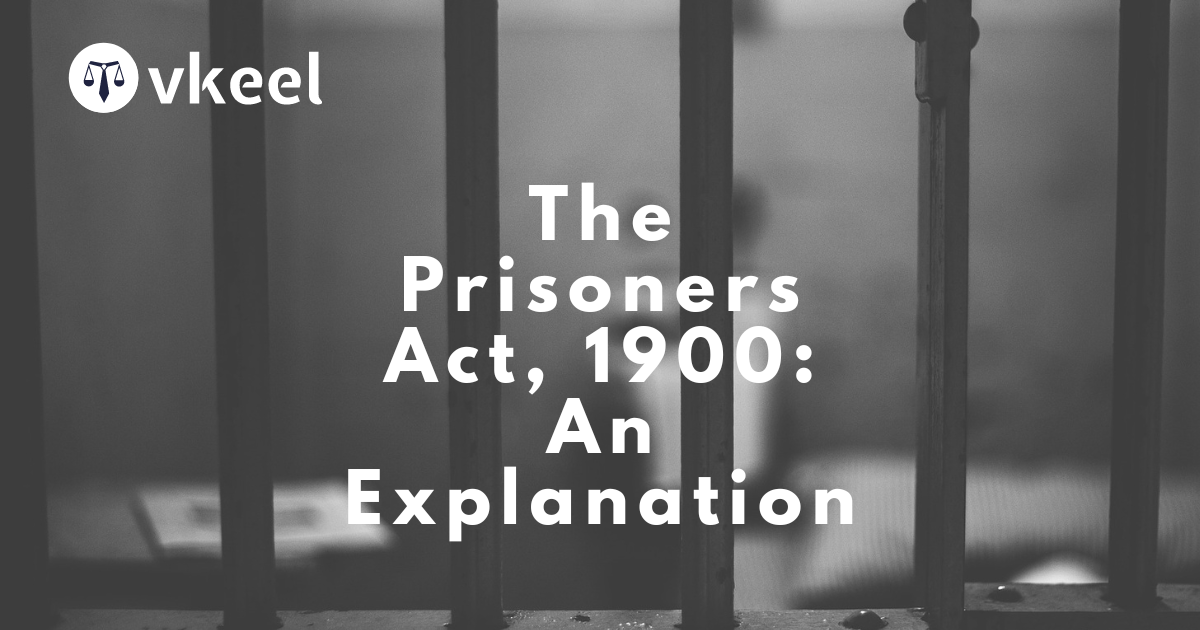The Prisoners Act, 1900: An Explanation
By Himanshu Kumar
Table of Contents
Introduction
The Prisoners Act, 1900, is a significant piece of legislation in India that governs the treatment, rights, and management of prisoners. Passed during the British colonial period, this Act has continued to play a crucial role in the Indian penal system, guiding the administration of prisons and the handling of prisoners.
The primary objective of the Prisoners Act, 1900, is to provide a comprehensive legal framework for the administration of prisons and the treatment of prisoners in India. This legislation aims to ensure that the rights of prisoners are protected, their basic needs are met, and they are treated with dignity and humanity while incarcerated. By establishing guidelines for the classification of prisoners, the Act seeks to maintain discipline within prison facilities and ensure the safety and security of both inmates and staff. Additionally, the Prisoners Act, 1900, facilitates the transfer of prisoners between different facilities, allowing for better management of prison populations and addressing issues such as overcrowding and security concerns.
Another key objective of the Prisoners Act, 1900, is to promote rehabilitation and reintegration of prisoners into society. The Act includes provisions for temporary release on parole under certain conditions, allowing prisoners to maintain connections with their families and communities while serving their sentences. By emphasizing the humane treatment of prisoners and supporting their rehabilitation, the Act aims to reduce recidivism rates and contribute to the overall goal of a more just and rehabilitative criminal justice system.
Historical Background
The Prisoners Act, 1900, was enacted during the British rule in India to consolidate and amend the laws relating to prisoners. Before this Act, prison management was governed by various fragmented regulations, leading to inconsistencies and inefficiencies in the system. The 1900 Act aimed to create a uniform legal framework to improve prison administration and ensure the proper treatment of prisoners.
Colonial authorities were influenced by reforms in the British prison system and sought to introduce similar standards in India. The Act laid down guidelines for the classification, treatment, and transfer of prisoners, reflecting contemporary penal philosophy that emphasized discipline and deterrence.
Key Features of the Prisoners Act, 1900
The Prisoners Act, 1900, provides a detailed framework for the administration of prisons and the treatment of prisoners. Some of its salient features include:
- Classification of Prisoners: The Act categorizes prisoners into different classes, such as civil and criminal prisoners, and further distinguishes between convicted and undertrial prisoners. This classification is crucial for determining the treatment and privileges accorded to each category.
- Transfer of Prisoners: The Act includes provisions for the transfer of prisoners between different prisons within a state and between states. This ensures better management of prison populations and addresses issues of overcrowding.
- Temporary Release on Parole: The Act allows for the temporary release of prisoners on parole for specific reasons, such as health, family emergencies, or good behavior. This provision aims to facilitate the reintegration of prisoners into society and support their rehabilitation.
- Rights of Prisoners: The Act outlines the basic rights of prisoners, including access to food, clothing, medical care, and the ability to receive visitors. It also provides for the protection of prisoners from abuse and mistreatment.
- Discipline and Punishment: The Act sets out the rules for maintaining discipline within prisons and prescribes punishments for violations of prison rules. These measures are designed to maintain order and ensure the smooth functioning of prison facilities.
- Administration and Oversight: The Act mandates the appointment of various prison officials, such as wardens and superintendents, and specifies their duties and responsibilities. It also includes provisions for the inspection of prisons by government authorities to ensure compliance with regulations.
Significant Case Laws
Several landmark judgments have shaped the interpretation and enforcement of the Prisoners Act, 1900, contributing to the evolution of prisoners’ rights in India. Here are some notable cases:
- Sunil Batra v. Delhi Administration (1978): This case is a landmark in the realm of prisoners’ rights in India. The Supreme Court held that prisoners retain all fundamental rights except those necessarily curtailed by incarceration. The Court emphasized the humane treatment of prisoners and condemned the practice of solitary confinement and other inhumane treatments.
- Charles Sobhraj v. Superintendent, Central Jail, Tihar (1978): In this case, the Supreme Court addressed the issue of prison conditions and the rights of prisoners to fair treatment. The Court ruled that prisoners should not be deprived of their basic human rights and that prison authorities must ensure decent living conditions.
- D.K. Basu v. State of West Bengal (1997): Although primarily concerning custodial deaths, this case had significant implications for prisoners’ rights. The Supreme Court laid down detailed guidelines to prevent custodial torture and abuse, reinforcing the need for transparency and accountability in the treatment of prisoners.
- State of Andhra Pradesh v. Challa Ramkrishna Reddy (2000): This case addressed the issue of compensation for prisoners who suffer injuries or death due to the negligence of prison authorities. The Supreme Court held that the state is liable to compensate prisoners for any harm caused by the negligence or misconduct of prison staff.
Amendments to the Prisoners Act, 1900
Over the years, the Prisoners Act, 1900, has undergone several amendments to address emerging challenges and improve the administration of prisons. Key amendments include:
- Prisoners (Amendment) Act, 1955: This amendment introduced changes to the parole system, making provisions for the temporary release of prisoners on certain conditions. It aimed to facilitate the reintegration of prisoners into society and support their rehabilitation.
- Model Prison Manual (2003): Although not an amendment to the Act itself, the Model Prison Manual, issued by the Ministry of Home Affairs, provides comprehensive guidelines for the administration of prisons. It includes provisions for the treatment of prisoners, prison conditions, and the rights of prisoners, aligning with contemporary standards of human rights and prison management.
- Criminal Law Amendment Act, 2013: This amendment, in response to the Nirbhaya case, introduced significant changes to the penal system, including the treatment of prisoners convicted of sexual offenses. It mandated stricter punishment and improved the oversight of such prisoners to ensure they do not pose a threat to society.
- Digital Initiatives and Modernization: Recent efforts have focused on the modernization of prison administration through digital initiatives. The implementation of the e-Prisons project aims to improve the management of prison records, enhance transparency, and facilitate better monitoring of prisoners’ rights and conditions.
Impact of the Prisoners Act, 1900
The Prisoners Act, 1900, has had a profound impact on the administration of prisons and the treatment of prisoners in India. Its implementation has led to several positive outcomes:
- Improved Prison Management: The Act has provided a structured framework for the administration of prisons, leading to better management and organization. The classification of prisoners, guidelines for discipline, and provisions for the transfer and temporary release of prisoners have contributed to more efficient prison operations.
- Protection of Prisoners’ Rights: The Act’s emphasis on the basic rights of prisoners, such as access to food, medical care, and protection from abuse, has helped safeguard the dignity and well-being of prisoners. Landmark judgments have reinforced these rights, ensuring humane treatment and preventing mistreatment and exploitation.
- Rehabilitation and Reintegration: Provisions for parole and temporary release have facilitated the reintegration of prisoners into society. These measures support the rehabilitation process, helping prisoners transition back into the community and reducing recidivism rates.
- Judicial Oversight: Significant case laws have played a crucial role in interpreting and enforcing the provisions of the Act. Judicial interventions have highlighted the need for transparency, accountability, and the protection of prisoners’ rights, leading to reforms and improvements in the penal system.
- Challenges and Criticisms: Despite its successes, the implementation of the Prisoners Act faces challenges. Issues such as overcrowding, inadequate infrastructure, and understaffing persist, affecting the quality of prison administration. Additionally, there are criticisms regarding the need for further modernization and the adoption of international best practices in prison management.
Conclusion
The Prisoners Act, 1900, remains a cornerstone of India’s legal framework for the administration of prisons and the treatment of prisoners. Its provisions have significantly influenced the management of prison facilities, the protection of prisoners’ rights, and the overall functioning of the penal system. Landmark case laws and judicial interventions have further strengthened the Act’s impact, ensuring humane treatment and reinforcing the principles of justice and fairness.
While the Act has brought about notable improvements in prison administration, ongoing efforts are required to address emerging challenges and to modernize the system. Future amendments and reforms should focus on enhancing infrastructure, addressing overcrowding, and adopting contemporary best practices in prison management.
As India continues to evolve and reform its penal system, the Prisoners Act, 1900, will remain a vital legal instrument, guiding the administration of justice and ensuring the humane treatment of prisoners. Its legacy and impact on the Indian criminal justice system underscore the importance of a balanced approach that upholds the rights and dignity of individuals while maintaining order and security within the prison system.
Disclaimer:
The information provided in the article is for general informational purposes only, and is not intended to constitute legal advice or to be relied upon as a substitute for legal advice. Furthermore, any information contained in the article is not guaranteed to be current, complete or accurate. If you require legal advice or representation, you should contact an attorney or law firm directly. We are not responsible for any damages resulting from any reliance on the content of this website.







